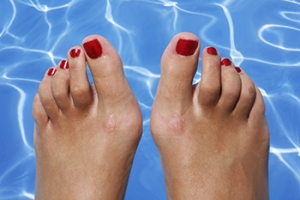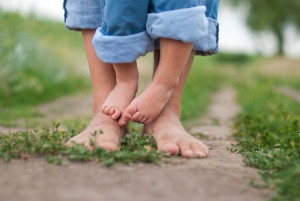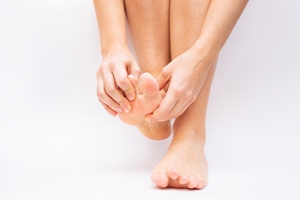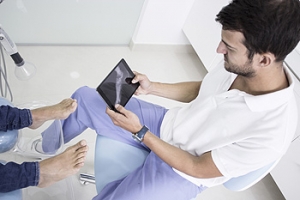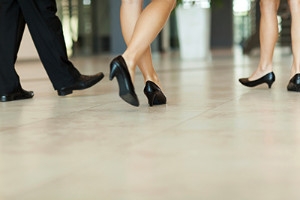Connect With Us
Featured Articles
Super User
Preventing Running Injuries With Gradual Changes

When an individual engages in running, it is possible that they may develop some kind of foot injury if the necessary measures are not taken. For instance, if the runner does not use proper form, they may be setting themselves up for a foot injury. However, runners may also be increasing the risk of injuring their feet by quickly or suddenly changing the nature of their workout. Namely, if a runner suddenly and dramatically increases the mileage of their daily run, then this might yield detrimental consequences. Instead of dramatically doubling or tripling the mileage, a runner might consider slowly and gradually increasing the mileage by 10% increments. This ensures that the feet are able to adapt to the longer distance. If you are a runner and are interested in protecting the feet, schedule an appointment with a podiatrist today.
Exercising your feet regularly with the proper foot wear is a great way to prevent injuries. If you have any concerns about your feet, contact Dr. Howard Horowitz of Bowie Foot & Ankle . Our doctor will treat your foot and ankle needs.
How to Prevent Running Injuries
Many common running injuries are caused by overuse and overtraining. When the back of the kneecap starts wearing out and starts causing pain in your knee, this is commonly referred to as runner’s knee. Runner’s knee is a decrease in strength in your quadriceps and can occur if you’re not wearing properly fitted or supporting shoes. To prevent runner’s knee, focusing on hip strengthening is a good idea, as well as strengthening your quads to keep the kneecaps aligned.
What Are Some Causes of Running Injuries?
- One cause of a common running injury is called iliotibial band syndrome.
- Plantar fasciitis is also another common injury.
- Stress fractures can occur from overtraining, lack of calcium, or even your running style.
Best Ways to Prevent Running Injuries
- Wear footwear that fits properly and suits your running needs.
- Running shoes are the only protective gear that runners have to safeguard them from injury.
- Make a training schedule. Adding strengthening exercises as well as regular stretching can help keep you strong and limber and can lessen the possibility of injuries.
- Stretching keeps muscles limber; this will help you gain better flexibility.
If you have any questions please feel free to contact our office located in Bowie, MD . We offer the newest diagnostic and treatment technologies for all your foot and ankle needs.
Freestyle Swimming and Foot Pain
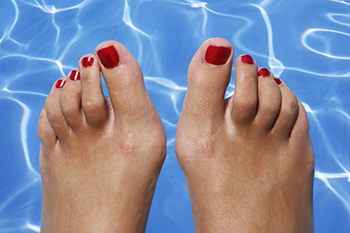
Feet help propel the body forward when swimming. Range of foot motion, flexible ankles, and pointed toes are important for flutter kicks in freestyle swimming. However, muscle cramps can occur while swimming, which can be painful. In fact, the most frequent injury in this activity is from cramping. This can happen from overworking the muscles and from overtraining with weights. Cramping can also occur from dehydration in muscles. Inflammation and tendonitis from repetitive foot and ankle movements and pointing and flexing toes excessively while swimming can also occur. Poor swimming technique can contribute to such pain. One should drink plenty of water and use drinks fortified with electrolytes as well as relax the muscles for two or three days after training. A warm-up session before swimming can help to avoid cramping and pain on the tops of the feet, as well as improve muscle and joint flexibility. Likewise, stretching the ankles and toes can help prepare for more comfortable swimming. If you are a swimmer and experience foot pain, consult with a podiatrist who can offer you more advice and treatment options.
Ankle and foot injuries are common among athletes and in many sports. They can be caused by several problems and may be potentially serious. If you are feeling pain or think you were injured in a sporting event or when exercising, consult with Dr. Howard Horowitz from Bowie Foot & Ankle . Our doctor will assess your condition and provide you with quality foot and ankle treatment.
Common Injuries
The most common injuries that occur in sporting activities include:
- Achilles Tendonitis
- Achilles Tendon Rupture
- Ankle Sprains
- Broken Foot
- Plantar Fasciitis
- Stress Fractures
- Turf Toe
Symptoms
Symptoms vary depending upon the injury and in some cases, there may be no symptoms at all. However, in most cases, some form of symptom is experienced. Pain, aching, burning, bruising, tenderness, tightness or stiffness, sensation loss, difficulty moving, and swelling are the most common symptoms.
Treatment
Just as symptoms vary depending upon the injury, so do treatment options. A common treatment method is known as the RICE method. This method involves rest, applying ice, compression and elevating the afflicted foot or ankle. If the injury appears to be more serious, surgery might be required, such as arthroscopic or reconstructive surgery. Lastly, rehabilitation or therapy might be needed to gain full functionality in the afflicted area. Any discomfort experienced by an athlete must be evaluated by a licensed, reputable medical professional.
If you have any questions, please feel free to contact our office located in Bowie, MD . We offer the newest diagnostic and treatment technologies for all your foot care needs.
Walking Barefoot Inside and Outside
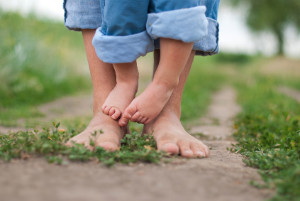
There are countries around the globe that encourage children to walk barefoot during inside and outside activities. Research has shown that wearing shoes at an early age may negatively affect the gait, or walking style, and there may be evidence that supports children who wear shoes before the age of six may be prone to having flat feet. Conversely, walking barefoot during these same years may have numerous benefits that can affect more than the feet. These can include improved motor skills, and increased foot strength, and the nerve endings in the feet may be stimulated. Additionally, potential injuries may be prevented when children walk barefoot, and this may be a result of having wider feet that can distribute body weight more evenly. The feet can feel like they are being massaged while walking on different outside surfaces such as grass and sand. The arches may become stronger while walking on various surfaces that can including uneven ground and pebbles, which may help to develop a normal gait pattern. If you have concerns about having your child walk barefoot, please consult with a podiatrist who can answer any questions you may have.
Making sure that your children maintain good foot health is very important as they grow. If you have any questions, contact Dr. Howard Horowitz of Bowie Foot & Ankle . Our doctor can provide the care you need to keep you pain-free and on your feet.
Keeping Children's Feet Healthy
Having healthy feet during childhood can help prevent medical problems later in life, namely in the back and legs. As children grow, their feet require different types of care. Here are some things to consider...
Although babies do not walk yet, it is still very important to take care of their feet.
Avoid putting tight shoes or socks on his or her feet.
Allow the baby to stretch and kick his or her feet to feel comfortable.
As a toddler, kids are now on the move and begin to develop differently. At this age, toddlers are getting a feel for walking, so don’t be alarmed if your toddler is unsteady or ‘walks funny’.
As your child gets older, it is important to teach them how to take care of their feet.
Show them proper hygiene to prevent infections such as fungus.
Be watchful for any pain or injury.
Have all injuries checked by a doctor as soon as possible.
Comfortable, protective shoes should always be worn, especially at play.
If you have any questions please feel free to contact our office located in Bowie, MD . We offer the newest diagnostic and treatment technologies for all your foot and ankle needs.
Simple Methods May Possibly Prevent Gout
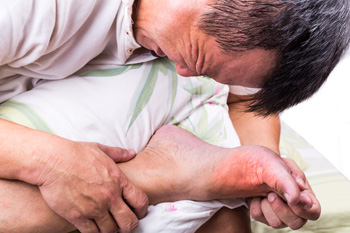
The inflammation and pain of the foot condition that is referred to as gout can be debilitating. It is a condition that affects the joints in the big toe and is caused by an abundance of uric acid in the blood. When there is excess uric acid, it can lodge in the big toe in the form of crystals and can be quite uncomfortable. There are specific types of foods that have high levels of purines, which can lead to having large amounts of uric acid in the bloodstream. These types of foods include red meat, shellfish, and sugary drinks. A gout flare-up may gradually improve within a few weeks, and methods can be implemented that may help to prevent future attacks from occurring. These consist of consuming a healthy diet, drinking plenty of water daily, and engaging in a gentle exercise program. Ideally, living a healthy lifestyle may significantly contribute to possibly avoiding gout attacks. If you suffer from this painful foot condition, it is strongly urged that you are under the care of a podiatrist who can guide you toward correct relief and prevention options.
Gout is a painful condition that can be treated. If you are seeking treatment, contact Dr. Howard Horowitz from Bowie Foot & Ankle . Our doctor will treat your foot and ankle needs.
What Is Gout?
Gout is a form of arthritis that is characterized by sudden, severe attacks of pain, redness, and tenderness in the joints. The condition usually affects the joint at the base of the big toe. A gout attack can occur at any random time, such as the middle of the night while you are asleep.
Symptoms
- Intense Joint Pain - Usually around the large joint of your big toe, and it most severe within the first four to twelve hours
- Lingering Discomfort - Joint discomfort may last from a few days to a few weeks
- Inflammation and Redness -Affected joints may become swollen, tender, warm and red
- Limited Range of Motion - May experience a decrease in joint mobility
Risk Factors
- Genetics - If family members have gout, you’re more likely to have it
- Medications - Diuretic medications can raise uric acid levels
- Gender/Age - Gout is more common in men until the age of 60. It is believed that estrogen protects women until that point
- Diet - Eating red meat and shellfish increases your risk
- Alcohol - Having more than two alcoholic drinks per day increases your risk
- Obesity - Obese people are at a higher risk for gout
Prior to visiting your podiatrist to receive treatment for gout, there are a few things you should do beforehand. If you have gout you should write down your symptoms--including when they started and how often you experience them, important medical information you may have, and any questions you may have. Writing down these three things will help your podiatrist in assessing your specific situation so that he or she may provide the best route of treatment for you.
If you have any questions, please feel free to contact our office located in Bowie, MD . We offer the newest diagnostic and treatment technologies for all your foot care needs.
Diagnosing a Broken Ankle
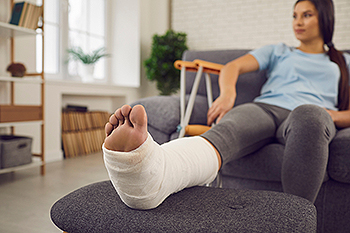
A broken ankle occurs when the bone endures a break, which can be either partial or complete. It can be very easy for an individual who has suffered a broken ankle to mistake it for an ankle sprain, and vice versa. Therefore, it is important to seek out medical attention from a doctor who can perform a proper diagnosis to confirm what the injury is. If you seek out attention from a podiatrist, this medical professional will examine you, touching specific areas of the feet or ankles. This can give the podiatrist a better understanding of the nature of your injury. Then, as part of the diagnosis, a podiatrist might want to perform an imaging procedure, such as an X-ray, to better observe the affected bones in the feet or ankles. It is important to remember that receiving this diagnosis should be done as soon as possible after enduring a broken ankle. If you suspect that you have broken your ankle, schedule an appointment with a podiatrist today.
Broken ankles need immediate treatment. If you are seeking treatment, contact Dr. Howard Horowitz from Bowie Foot & Ankle . Our doctor can provide the care you need to keep you pain-free and on your feet.
Broken Ankles
A broken ankle is experienced when a person fractures their tibia or fibula in the lower leg and ankle area. Both of these bones are attached at the bottom of the leg and combine to form what we know to be our ankle.
When a physician is referring to a break of the ankle, he or she is usually referring to a break in the area where the tibia and fibula are joined to create our ankle joint. Ankles are more prone to fractures because the ankle is an area that suffers a lot of pressure and stress. There are some obvious signs when a person experiences a fractured ankle, and the following symptoms may be present.
Symptoms of a Fractured Ankle
- Excessive pain when the area is touched or when any pressure is placed on the ankle
- Swelling around the area
- Bruising of the area
- Area appears to be deformed
If you suspect an ankle fracture, it is recommended to seek treatment as soon as possible. The sooner you have your podiatrist diagnose the fracture, the quicker you’ll be on the way towards recovery.
If you have any questions, please feel free to contact our office located in Bowie, MD . We offer the newest diagnostic and treatment technologies for all your foot care needs.
All About Broken Ankles
Broken ankles are a serious injury that can lead to an inability to walk, function, and also cause a significant amount of pain. A broken ankle is a break in one of the three bones in your body that connect at the ankle joint: the tibia, the fibula, and the talus. The tibia and fibula are your two primary leg bones that connect at the knee, which sit directly upon the talus bone. This is protected by a fibrous membrane that allows for movement in the ankle joint. A broken ankle is usually caused by the foot rolling under or twisting too far, causing one of these three bones to snap.
A broken ankle is different from an ankle sprain, which occurs when the ankle ligaments are ripped or torn but no bones have been broken. A sprain can still be very severe, causing bruising in the foot and an inability to hold your own weight, much like a broken ankle would. If you’re unable to stand, and suspect that you have a broken ankle, the first thing to do would be to get an immediate X-ray to determine the severity of the break.
A common cause of broken ankles is when the ankle is rolled over with enough pressure to break the bones. This usually happens during exercise, sports, or other physical activity. Another common cause is a fall or jump from a tall height.
One immediate treatment for pain relief is elevating the foot above your head to reduce blood flow to the injured area. You can also apply ice packs to your ankle to help reduce swelling, redness, inflammation, and pain. After these initial steps, getting a cast and staying off your feet as much as possible will aid in the recovery of the broken ankle. The less movement and stress the ankle has to endure, the more complete it will heal. A doctor can determine if surgery is needed in order to heal correctly. In these cases, an operation may be the only option to ensure the ability to walk properly again, followed by physical therapy and rehabilitation.
It is highly important to determine if surgery is needed early on, because a broken ankle can become much more severe than you realize. If not professionally treated, the broken ankle will inhibit your walking, daily functioning, and produce a large amount of pain. Treating your broken ankle early on will help prevent further damage to it.
Numerous Changes Can Occur to the Feet During Pregnancy

Most women are aware of the changes that happen to their bodies during pregnancy, and the feet are no exception. It is common to have swollen feet which typically results from the excess build-up of fluid that occurs due to the growing fetus. Additionally, the medical reason for the feet to undergo changes can be from the natural process of producing the pregnancy hormone called relaxin. This can cause the muscles, tendons, and ligaments to loosen, and the feet may become wider. The legs and feet can experience reduced circulation, so it is beneficial to elevate them frequently during the day. It is essential to wear shoes that fit correctly, and this may help the arch to absorb the shock the feet endure when walking. As the pregnancy progresses, the center of gravity within the body may shift and cause uneven wear and tear on your shoes. Since the feet can endure many changes during pregnancy, it is suggested that you get the expert advice of a podiatrist.
Pregnant women with swollen feet can be treated with a variety of different methods that are readily available. For more information about other cures for swollen feet during pregnancy, consult with Dr. Howard Horowitz from Bowie Foot & Ankle . Our doctor will attend to all of your foot and ankle needs.
What Foot Problems Can Arise During Pregnancy?
One problem that can occur is overpronation, which occurs when the arch of the foot flattens and tends to roll inward. This can cause pain and discomfort in your heels while you’re walking or even just standing up, trying to support your baby.
Another problem is edema, or swelling in the extremities. This often affects the feet during pregnancy but tends to occur in the later stages.
How Can I Keep My Feet Healthy During Pregnancy?
- Wearing orthotics can provide extra support for the feet and help distribute weight evenly
- Minimize the amount of time spent walking barefoot
- Wear shoes with good arch support
- Wear shoes that allow for good circulation to the feet
- Elevate feet if you experience swelling
- Massage your feet
- Get regular, light exercise, such as walking, to promote blood circulation to the feet
If you have any questions please feel free to contact our office located in Bowie, MD . We offer the newest diagnostic and treatment technologies for all your foot and ankle needs.
Why Toe Pain Occurs
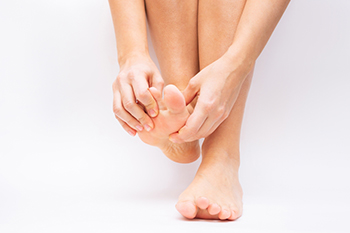
The function of the big toe is to provide and maintain balance while daily activities are completed. The big toe is also essential for participating in running and jumping activities. Many people can get pain in their big toe and this can happen for a variety of reasons. Arthritis is a condition that can cause pain in this toe, affecting the joints. In severe cases, arthritis can be crippling and may cause difficulties in walking. People who enjoy running may be prone to gradually developing arthritis in the toe and this may be accompanied by swelling and stiffness. Gout can also cause debilitating pain in the joints of the big toe. It can occur for genetic reasons or from eating foods that have high levels of purines, causing an elevation in uric levels. This can cause crystals to form in the joints of the big toe and it is often difficult to walk. Extensor tendonitis can develop from having tight calf muscles and arthritis that affects the joints. If you have toe pain for any reason, it is strongly advised that you seek the counsel of a podiatrist who can determine what the cause is and treat it accordingly.
Toe pain can disrupt your daily activities. If you have any concerns, contact Dr. Howard Horowitz of Bowie Foot & Ankle . Our doctor can provide the care you need to keep you pain-free and on your feet.
What Causes Toe Pain?
Most severe toe pain is caused due to a sports injury, trauma from dropping something heavy on the toe, or bumping into something rigid. Other problems can develop over time for various reasons.
Toe pain can be caused by one or more ailments. The most common include:
- Trauma
- Sports injury
- Wearing shoes that are too tight
- Arthritis
- Gout
- Corns and calluses
- Hammertoe
- Bunions
- Blisters
- Ingrown toenails
- Sprains
- Fractures (broken bones)
- Dislocations
When to See a Podiatrist
- Severe pain
- Persistent pain that lasts more than a week
- Signs of infection
- Continued swelling
- Pain that prevents walking
Diagnosis
In many cases the cause of toe pain is obvious, but in others, a podiatrist may want to use more advanced methods to determine the problem. These can range from simple visual inspections and sensation tests to X-rays and MRI scans. Prior medical history, family medical history, and any recent physical traumatic events will all be taken into consideration for a proper diagnosis.
Treatment
Treatments for toe pain and injuries vary and may include shoe inserts, padding, taping, medicines, injections, and in some cases, surgery. If you believe that you have broken a toe, please see a podiatrist as soon as possible.
If you have any questions please feel free to contact our office located in Bowie, MD . We offer the newest diagnostic tools and technology to treat your foot and ankle needs.
When to See a Podiatrist
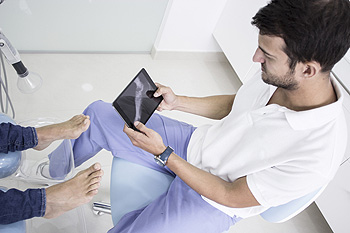
A podiatrist is a doctor that treats the foot, ankle, and any connecting leg parts. They are known as a doctor of podiatric medicine or DPM, and these initials will appear after their name. Podiatrists must complete four years of study and training at a podiatric medical school. After this, they must complete residency training for three more years in a hospital or clinic. When they pass all required exams, they are certified by the American Board of Podiatric Medicine (APMA). Some of these doctors choose to specialize (such as in surgery, sports medicine, or pediatrics), and if they do this, they must obtain more training in their area of specialty. Podiatrists must be licensed in the state that they work in, and like other physicians, they must renew their licenses and keep up to date with their training. Like a family doctor or general care physician, unless they specialize, podiatrists treat people of all ages and for a range of conditions. If your feet hurt or if you have sustained an injury to your feet or ankles, it is time to see a podiatrist who can diagnose the problem and provide appropriate treatment. It is a good idea to have your feet checked by this type of doctor periodically anyway. Remember, your feet support your weight and get you through a lifetime of mobility.
If you are experiencing pain in the feet or ankles, don’t join the stubborn majority refusing treatment. Feel free to contact Dr. Howard Horowitz from Bowie Foot & Ankle . Our doctor can provide the care you need to keep you pain-free and on your feet.
What Is a Podiatrist?
Someone would seek the care of a podiatrist if they have suffered a foot injury or have common foot ailments such as heal spurs, bunions, arch problems, deformities, ingrown toenails, corns, foot and ankle problems, etc.
Podiatric Treatment
A podiatrist will treat the problematic areas of the feet, ankle or lower leg by prescribing the following:
- Physical therapy
- Drugs
- Orthotic inserts or soles
- Surgery on lower extremity fractures
A common podiatric procedure a podiatrist will use is a scanner or force plate which will allow the podiatrist to know the designs of orthotics. Patients are then told to follow a series of tasks to complete the treatment. The computer will scan the foot a see which areas show weight distribution and pressure points. The podiatrist will read the analysis and then determine which treatment plans are available.
If you have any questions please feel free to contact our office located in Bowie, MD . We offer the newest diagnostic and treatment technologies for all your foot and ankle needs.
Working On Your Feet While Pregnant
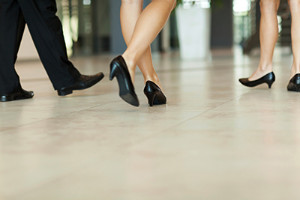
Many individuals throughout the American workforce spend a significant amount of the workday on their feet. For example, cooks, construction workers, and hairstylists spend most of their time on the clock standing on their feet. There are a few things to be mindful of, however, for pregnant women who hold jobs that require them to stand all day. Standing for prolonged periods while pregnant can not only be dangerous, but it can also be difficult or painful. It is recommended that pregnant women stand for no more than four or five hours while taking frequent breaks throughout the workday. Since pregnant women’s feet are prone to swelling, it is more important to listen to your body and give your feet the rest that they need. As the pregnancy progresses, a woman might notice standing becomes increasingly difficult throughout the workday. Pregnant women might choose to lie down during breaks as well as stay hydrated and elevate their feet. Working on one’s feet is certainly nothing to take lightly, particularly if you are pregnant or are planning to be. Consult with a podiatrist for the best advice on maintaining the health of your feet.
While working on the feet, it is important to take the proper care of them. For more information about working on your feet, contact Dr. Howard Horowitz from Bowie Foot & Ankle . Our doctor will treat your foot and ankle needs.
Working on Your Feet
Standing on your feet for long periods of time can cause stress and pain in your feet. Your whole body may experience change in terms of posture, back pain, bunions, callouses and or plantar warts. There are ways to avoid these conditions with proper foot care, smart choices and correct posture.
Positive Changes
Negative heeled shoe – Choosing this shoe type places the heel slightly lower than the ball of the foot. These are great for overall foot health. Find shoes that fit you correctly.
Go barefoot – Our feet were not designed to be enclosed for all hours of the day. Try to periodically expose your feet to air.
Eliminate Pain
Foot Exercises – Performing simple exercises, incorporating yoga and doing stretches are beneficial. This will allow increased blood flow to the area and muscles of the foot.
Achilles tendon – Stretching the foot out flat on the floor will relax the calf muscles and tendon. These exercises can be performed almost anywhere. Make sure you add these exercises to your daily regimen.
With a little bit of this information and knowing more about foot health, you will notice changes. Foot stretches and proper footwear will help with pain and prevent further issues.
If you have any questions please feel free to contact our office located in Bowie, MD . We offer the newest diagnostic and treatment technologies for all your foot and ankle needs.

